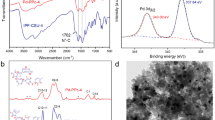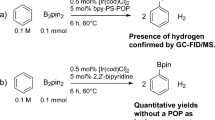Abstract
A new type melamine-based porous organic polymers (SZU-1) has been synthesized with melamine and 2,2′-bipyridyl-5,5′-dialdehyde by a one-pot method and fully characterized. Divalent palladium salts were coordinated to this polymer network which successfully catalyzed the nucleophilic addition reaction of arylboronic acids to aromatic aldehydes. With only 1.0 mol% heterogeneous catalyst loading, high reaction yields (> 85%) can be achieved in most cases. The scope of substrates was also investigated and the catalyst showed universal applicability.
Graphic Abstract
The loose and porous melamine-based porous organic polymers (SZU-1) are synthesized by melamine and 2,2′-bipyridyl-5,5′-dialdehyde. The performance of SZU-1 was characterized and most of the substrates achieved high yield (> 85%) in the catalytic performance test.









Similar content being viewed by others
References
Maly KE (2009) Assembly of nanoporous organic materials from molecular building blocks. J Mater Chem 19:1781–1787
McKeown NB, Budd PM (2006) Polymers of intrinsic microporosity (PIMs): organic materials for membrane separations, heterogeneous catalysis and hydrogen storage. Chem Soc Rev 35:675–683
Spokoyny AM, Kim D, Sumrein A, Mirkin CA (2009) Infinite coordination polymer nano-and microparticle structures. Chem Soc Rev 38:1218–1227
Tranchemontagne DJ, Mendoza-Cortés JL, O’Keeffe M, Yaghi OM (2009) Secondary building units, nets and bonding in the chemistry of metal–organic frameworks. Chem Soc Rev 38:1257–1283
Davis ME (1993) New vistas in zeolite and molecular sieve catalysis. Acc Chem Res 26:111–115
Geng K, He T, Liu R, Dalapati S, Tan TK, Li ZP, Tao SS, Gong YF, Jiang QH, Jiang DL (2020) Covalent organic frameworks: design, synthesis, and functions. Chem Rev 120:8814–8933
Zhang Y, Ying JY (2015) Main-chain organic frameworks with advanced catalytic functionalities. ACS Catal 5:2681–2691
Huang K, Zhang JY, Liu FJ, Dai S (2018) Synthesis of porous polymeric catalysts for the conversion of carbon dioxide. ACS Catal 8:9079–9102
Kaur P, Hupp JT, Nguyen SBT (2011) Porous organic polymers in catalysis: opportunities and challenges. ACS Catal 1:819–835
Kramer S, Bennedsen NR, Kegnæs S (2018) Porous organic polymers containing active metal centers as catalysts for synthetic organic chemistry. ACS Catal 8:6961–6982
Liu FJ, Kong WP, Qi CZ, Zhu LF, Xiao FS (2012) Design and synthesis of mesoporous polymer-based solid acid catalysts with excellent hydrophobicity and extraordinary catalytic activity. ACS Catal 2:565–572
Liu FJ, Meng XJ, Zhang YL, Ren L, Nawaz F, Xiao FS (2010) Efficient and stable solid acid catalysts synthesized from sulfonation of swelling mesoporous polydivinylbenzenes. J Catal 271:52–58
Sun Q, Dai ZF, Meng XJ, Wang L, Xiao FS (2015) Task-specific design of porous polymer heterogeneous catalysts beyond homogeneous counterparts. J Catal 5:4556–4567
Lin SH, Lu XY (2007) Cationic Pd (II)/bipyridine-catalyzed addition of arylboronic acids to arylaldehydes. One-pot synthesis of unsymmetrical triarylmethanes. J Org Chem 72:9757–9760
Yang ZY, Ni YX, Liu R, Song KX, Lin SH, Pan QM (2017) In situ generated cationic Pd (II)/bipyridine-catalyzed addition of arylboronic acids to N-sulfonyl-arylaldimines. J Org Chem 58:2034–2037
Ni YX, Song KX, Shen K, Yang ZY, Liu R, Lin SH, Pan QM (2018) Cationic Pd (II)/bipyridine-catalyzed conjugate addition of arylboronic acids to α, β-unsaturated carboxylic acids in aqueous media. Tetrahedron Lett 59:1192–1195
Conley MP, Coperet C, Thieuleux C (2014) Mesostructured hybrid organic–silica materials: ideal supports for well-defined heterogeneous organometallic catalysts. ACS Catal 4:1458–1469
Zhang H, Li H, Xu CC, Yang S (2019) Heterogeneously chemo/enzyme-functionalized porous polymeric catalysts of high-performance for efficient biodiesel production. ACS Catal 9:10990–11029
Kong LY, Shan WD, Han SL, Zhang T, He LC, Huang K, Dai S (2018) Interfacial engineering of supported liquid membranes by vapor cross-linking for enhanced separation of carbon dioxide. ChemSusChem 11:185–192
Huang K, Liu F, Jiang L, Dai S (2017) Aqueous and template-free synthesis of meso-macroporous polymers for highly selective capture and conversion of carbon dioxide. ChemSusChem 10:4144–4149
Liu F, Huang K, Wu Q, Dai S (2017) Solvent-free self-assembly to the synthesis of nitrogen-doped ordered mesoporous polymers for highly selective capture and conversion of CO2. Adv Mater 29:1700445
Nasrallah H, Hierso JC (2018) Porous materials based on 3-dimensional Td-directing functionalized adamantane scaffolds and applied as recyclable catalysts. Chem Mater 31:619–642
Schwab MG, Fassbender B, Spiess HW, Thomas A, Feng XL, Müllen K (2009) Catalyst-free preparation of melamine-based microporous polymer networks through Schiff base chemistry. J Am Chem Soc 131:7216–7217
Chen J, Li H, Zhong MM, Yang QH (2016) Hierarchical mesoporous organic polymer with an intercalated metal complex for the efficient synthesis of cyclic carbonates from flue gas. Green Chem 18:6493–6500
Iwai T, Harada T, Hara K, Sawamura M (2013) Threefold cross-linked polystyrene–triphenylphosphane hybrids: mono-P-ligating behavior and catalytic applications for aryl chloride cross-coupling and C (sp3)- H borylation. Angew Chem Int Ed 52:12322–12326
Acknowledgements
We gratefully acknowledge the National Natural Science Foundation of China (Nos. 21104049, 21176163, 21576174), Specialized Research Fund for the Doctoral Program (SRFDP) of Higher Education (No. 20113201120006), the Priority Academic Program Development (PAPD) of Jiangsu Higher Education Institutions (Grant No. 2018), Soochow University Funds (Nos. 14109001, Q410900510) and Suzhou Industrial Park Fund for financial support.
Author information
Authors and Affiliations
Corresponding authors
Additional information
Publisher's Note
Springer Nature remains neutral with regard to jurisdictional claims in published maps and institutional affiliations.
Supplementary Information
Below is the link to the electronic supplementary material.
Rights and permissions
About this article
Cite this article
Shen, K., Wen, M., Fan, C. et al. Melamine-Based Porous Organic Polymers Supported Pd(II)-Catalyzed Addition of Arylboronic Acids to Aromatic Aldehydes. Catal Lett 151, 2612–2621 (2021). https://doi.org/10.1007/s10562-020-03508-1
Received:
Accepted:
Published:
Issue Date:
DOI: https://doi.org/10.1007/s10562-020-03508-1




